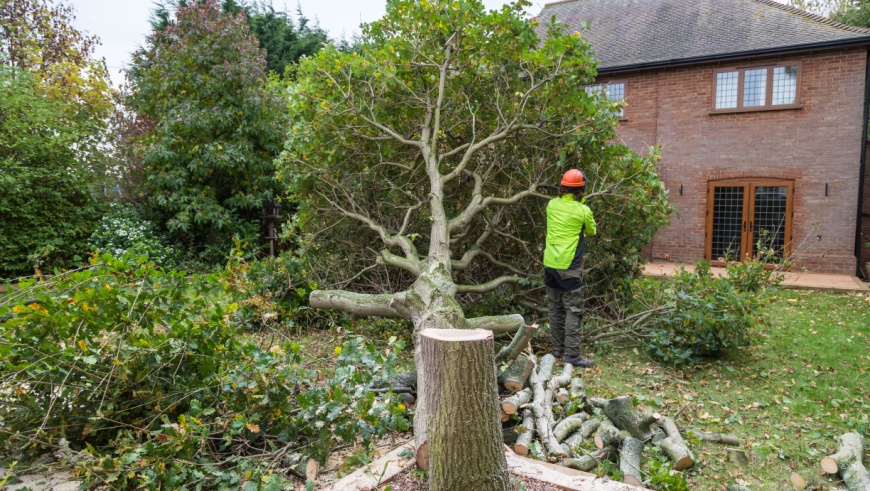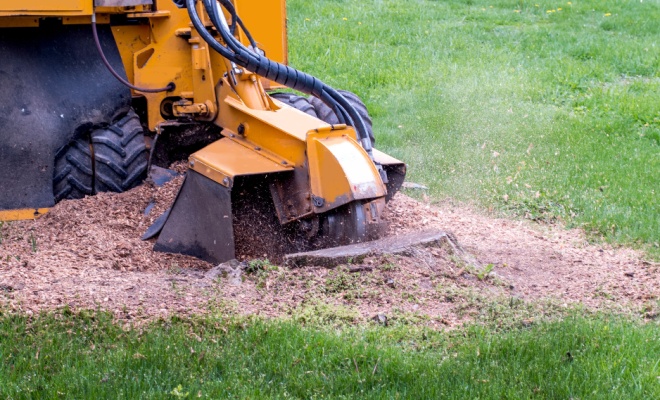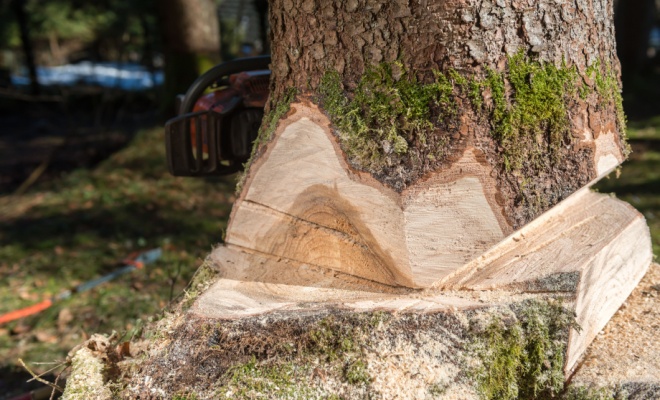Tree Removal Cost
Last updated 29th May, 2024
Want to find out the cost of tree cutting?
In this tree removal price guide, we provide the average cost (which will be at least £150) of cutting down trees depending on size and type of tree as well as tree surgeon cost.
For more detials on cutting trees down, read on below...

How Much to Remove a Tree?
The average cost to remove a tree can range in price massively depending upon numerous reasons including the height, diameter and type of tree, as well as its position in the garden.
What should be considered when felling a tree?
Naturally, the larger the tree the more expensive it will be to cut it down. Ease of access is important too as the more difficult it is to get to the tree the longer it will take and thus the cost will increase.
A tree surgeon will normally charge around £150-£200 per day in labour and will usually work with a general labourer or two.
As such you should expect to pay around £350 per day in labour costs if there are three tradesmen.
Tree Removal Prices
Below are some estimated costs of hiring a tree surgeon to fell a tree. These prices include cutting down the tree to it's stump as well as removing any waste. If you want the stump removing as well expect to add another £100-£500.
| Job Description | Avg. Cost | Duration |
|---|---|---|
| Small Trees (less than 25 ft) | £150-£350 | 3-4 hours |
| Medium-sized Trees (25 to 50 ft) | £200-£750 | 1 day |
| Large Trees (50 to 75 ft) | £650-£1200 | 1-2 days |
| Extra Large Trees (over 75 ft) | £1000-£2500 | 2-5 days |
Cost Breakdown Calculator
Individual costs for hiring a tree surgeon to fell a 25 ft tree, assuming it takes around half a day - Total Cost: £250
Materials
£25
Tradesmen
£200
Waste Removal
£25
What Tree Felling Entails
This article about tree felling forms part of our series about average landscape gardening prices.
Tree work is one of the hardest jobs to price without visiting the property and making an assessment, not only is every tree different but every garden also has differing access requirements! The price for felling a tree will ultimately depend on multiple factors including:
- Size of the tree.
- The overhang.
- Access.
- The type of tree.
- Proximity to public footpath or road.
- Disposal of the tree.
- If you want the stump grinded down or not.
The prices quoted will also vary depending on your location, with London and the Home Counties being considerably more expensive in terms of labour charges than elsewhere in the UK.
The height of tree is obviously a major factor because higher trees will require more equipment and time, plus of course there is also the higher risk of more severe damage and/or injury due to the fact it is further to fall! Extra care is needed at height, which means it takes more time and manpower.
If the tree overhangs a building such as a shed or greenhouse, then once again more care if required so the costlier the process. Problems with access will increase the costs for obvious reasons as simply getting the people and equipment safely to the site will take more time. Some trees are easier to work with than others so this has some impact on price but is not normally a huge factor.
If the tree overhangs a public road or footpath, then permission is required to close off the area which is expensive so will impact the overall cost. Once a tree has been felled, if you can dispose of the waste yourself perhaps adding to the compost heap and/or using as fuel for a wood burning stove.
Moving a felled tree to the front of a property and loading it onto a vehicle takes time and costs money, especially as trees can weigh several tonnes! You may want to consider hiring a skip as it may save you money, especially if it's a larger tree which requires numerous journeys to and from the tip. Stump grinding can stop the tree roots forming into a new tree so is worthwhile but again adds costs.
Felling a small tree with a diameter of 18″ or less can be done as a DIY project as long as there are no complications such as the tree is heavily leaning or overhanging a building or public path/road. There are no regulations in place to prevent amateurs felling trees on their own property providing there is no Tree Preservation Order in place.
But even though it can be done DIY, it is not recommended that you do so, tree felling is a dangerous job best left to professionals, even the smaller trees.

When trees are felled their stumps should be removed to prevent suckering (a new tree plant growing out of the old stump). Although stumps are often large and heavy, they can sometimes be completely removed with the right equipment.
Tree stumps can be removed any time, but paying tree surgeons to remove the stumps when they are felling the tree is the most convenient way as chemical stump killers need to be applied to the freshly cut wood immediately after felling.
Otherwise, the stump will need to be recut before the chemical stump killer is applied. Physical stump removal is the best solution if the stump can be removed entirely by pulling it out with a winch.
Failing that, grubbing out using a mechanical mini-excavator will remove the majority of the root system. Stump grinders can also mechanically grind out the main root plate into fine sawdust.
How Much Do Tree Surgeons Charge?
Removing trees is a highly skilled and dangerous job. It comes with costly equipment and high responsibility, so high insurance. As such, you can't expect tree surgeons to be cheap. Most tree surgeons will charge around £250 per day but will often give a price based on the job itself, so a fixed fee to remove a tree for example.
Keeping Safe When Tree Felling
Tree felling is a dangerous business with many risk factors including working at height and working with chainsaws. Tree felling operations must only be performed by people with suitable training and expertise. All felling operations must be carefully planned beforehand with a full risk assessment which details emergency contingencies.
In the last 10 years a total of 60 people have been killed in the UK as a result of tree work and many more have been badly injured or have suffered ill health.
If you do want to proceed without professional assistance, then do it safely by first clearing all obstacles from around the tree so that you can move easily. Then take away all the lower branches from the tree again for easier access. Plan an escape route not directly behind and if possible try to fell in the direction the tree is naturally leaning.
The first cut in the front of tree controls the direction of the fall and should not be more than one quarter of the diameter. Then the felling cut is started on the back of tree ensuring that you are standing to the side when making this cut. When the tree starts to fall move quickly out of the way to your safe place.
It cannot be emphasised enough that tree felling is dangerous and should not be attempted without having the knowledge and experience of using chain saws safely plus of course wearing the correct personal protective equipment.
Tree Felling Near Power Lines
There are overhead power lines all over the UK though they often go unnoticed. These above ground power cables are essential to provide electricity to cities, towns, villages and rural communities all over the UK. They can carry voltages from 230 volts up to 400,000 volts, but even the low voltages can be fatal. Many people die every year due to accidental contact with power lines.
Before you start work on trees or tall hedges always stand well back and check for any overhead power lines. If you are felling trees within two tree heights of a power line you should contact your local electricity vompany for advice before starting work. You must give the electricity company and give at least two weeks notice of any works.
The best way to stay safe is to stay well away from power lines and never fell or cut back any tree or vegetation that is touching or close to overhead power lines or the poles or towers that support them.
During work follow the advice given by the electricity company and avoid contact not just with power lines, but with the poles, towers and any wires which support the poles. Damage to power lines is not only extremely dangerous but also extremely expensive, you could well find yourself receiving a large bill from the electricity company to repair any damage you have caused!
Tree Felling in Conservation Areas
Notification of proposed works to trees in conservation areas is required for trees that have a trunk diameter of more than 75mm when measured at 1.5m from ground level. This notification has to be given six weeks prior to carrying out work on trees which are located in a conservation area to give the authority an opportunity to consider whether a preservation order should be made to protect the trees.
Tree Preservation Orders
A Tree Preservation Order is an order made by a local planning authority to protect specific trees or woodlands and prohibits the felling or lopping of trees without the local planning authority’s written consent. Owners of protected trees must not carry out or permit the carrying out of any work without the written consent of the local authority.
It is extremely unlikely that permission will be given to cut down a tree with a preservation order unless it is dangerous, but in some cases some work may be allowed as long as the tree is preserved, in these cases arboricultural advice from competent contractors and consultants should be sought to inform tree owners of their responsibilities and options.
Tree Felling with Wedges
Many trees lean a certain way but when felling it will be safer for them to fall in a different direction. Overcoming the lean of a tree during felling is not easy and to change the direction of the falling the tree to avoid other objects normally requires the use of wedges, though it can be done using guy ropes to keep the tree under control.
It is far from easy but experts are great at wedging the tree in any direction you desire. There are three main types of wedges in use which include felling, bucking, and splitting wedges.

Felling Wedges are placed in the back-cut to overcome the leaning of the tree, essentially as you cut you insert a wedge to gradually lift the tree on that side and change the direction of the lean while keeping much of the weight of the tree off of the chainsaw.
FAQs
For an 80-foot tree you will pay around £1000-£1500. The job is much more expensive as there are several extra tonnes of material to remove plus the height of the tree will require two tree surgeons and several labourers for a few days.
A Tree Preservation Order is an order made by councils in respect of trees to prohibit the unjustified pruning or felling of amenity trees without the council's consent.










